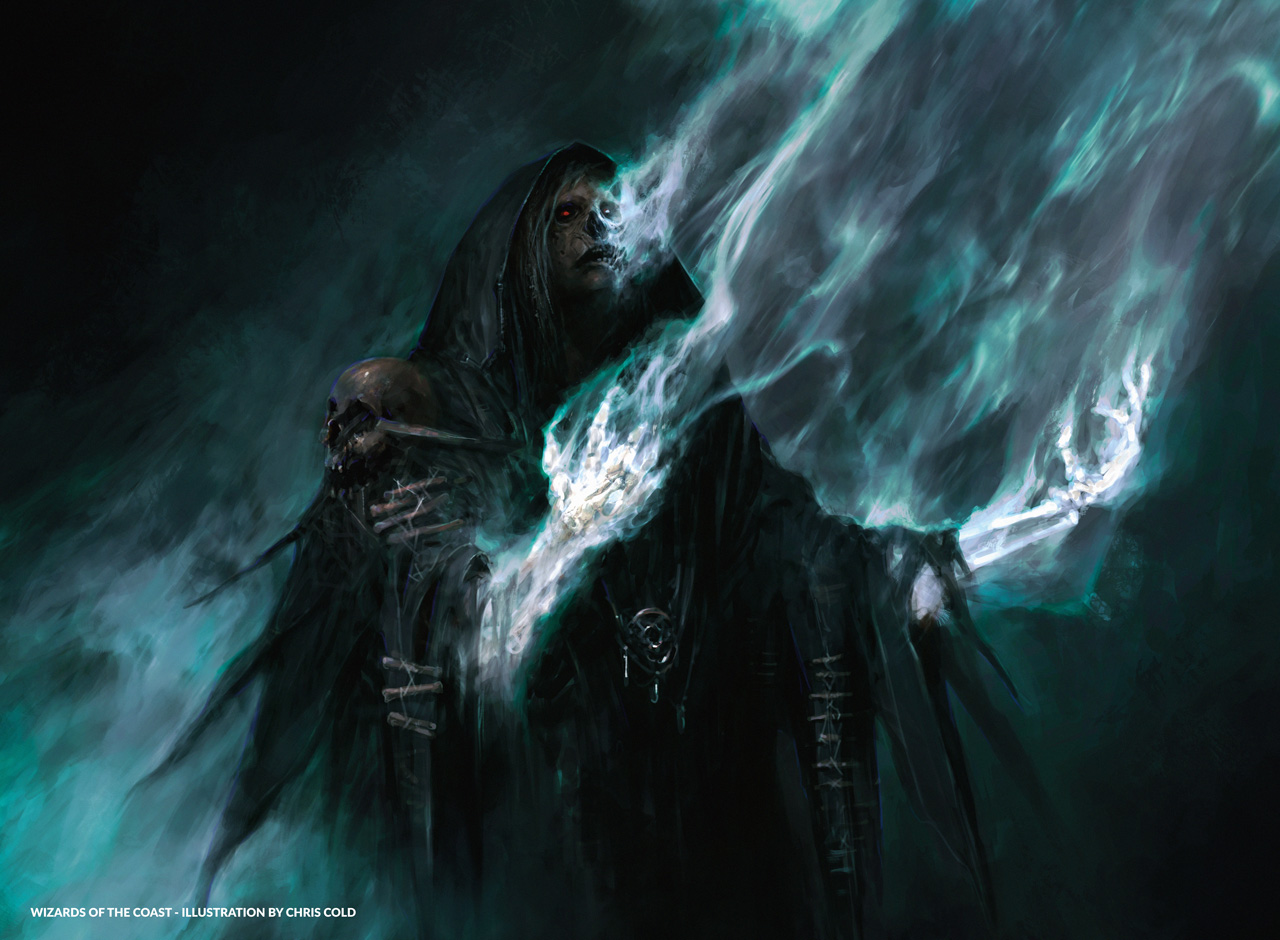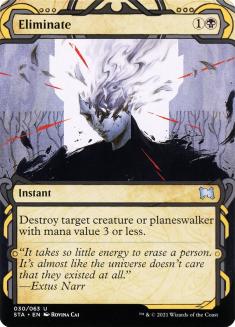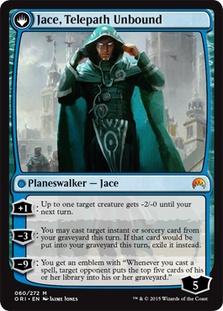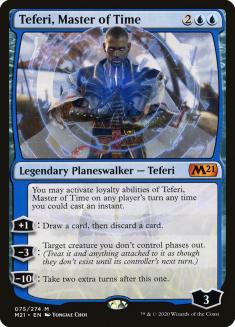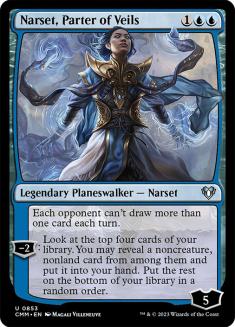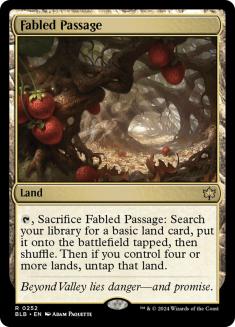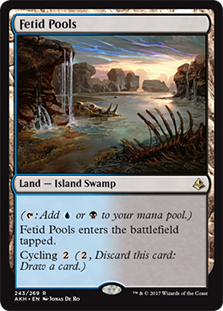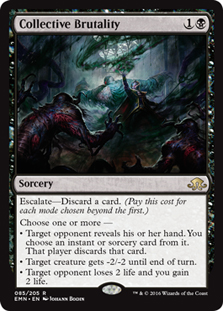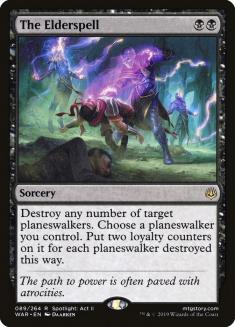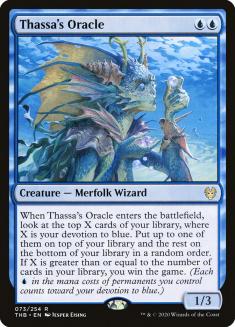Dimir Inverter is back, baby! To be fair, it never really left (although during Companion Spring, it was a weird 80-card Yorion, Sky Nomad version that tried to play a value-oriented game more than a straight combo game).
Now that we aren’t getting steamrolled by Lurrus of the Dream-Den or out-grinded by Yorion in both multicolor control decks and Mono-White Devotion, the time has come for Dimir Inverter to step back into its rightful place as the pre-eminent deck of Pioneer.
Here’s the list to use as a jumping-off point to rack up wins, courtesy of Players Tour Phoenix Top 8 competitor Peter Ingram:
Creatures (7)
Planeswalkers (6)
Lands (24)
Spells (23)

The biggest, most exciting new piece of the puzzle here is Eliminate from Core Set 2021.
Remember when Gideon of the Trials in Mono-White Devotion was the hot answer to older builds of Dimir Inverter? It feels like a lifetime ago, but there was a point in time when a resolved Gideon of the Trials was game over because Inverter didn’t have Hero’s Downfall at the time as a safety measure. People started picking up a couple of copies of the expensive removal spell or even playing with Ashiok, Nightmare Muse as measures to squeeze out from under the cheap planeswalker that stops Inverter cold.
Unfortunately, these cards are fairly clunky, leading to lost tempo and making it harder to stitch together the right cards in time to sneak through the win. If we look back at the Sultai version of Inverter that popped up in small numbers, we can take note of the fact that they all played some number of Abrupt Decay as the best, most flexible answer to Gideon.
Now there’s a monocolored Abrupt Decay that straight Dimir can play. It won’t be able to get artifacts and enchantments, but 90% of the functionality for a much easier color requirement is a true blessing. This will lead to a massive uptick in the number of double-spell turns for Inverter. A Dimir player will often turn a game into a total rout with double-spell turns involving removing an opposing Gideon and casting a Dig Through Time.
In addition to Eliminate, we’ve seen Dimir Inverter move Jace, Vryn’s Prodigy from the sideboard to the maindeck and now back to the sideboard. I agree completely with Mr. Ingram here in his decision to put more Narsets in his maindeck and leave the small Jaces to the sideboard. Let’s be frank — it’s rarely correct to put just a few creatures that can be hit profitably by cheap removal in your maindeck. The heuristic generally pushes us to want to have a deck with either lots of creatures or very few, because we want to either push through opponents’ removal and attack them or make their maindeck removal spells dead draws and gain virtual card advantage in our control decks. Playing exactly four cards that an opponent gets excited about targeting with Fatal Push is silly. (And no, opponents are generally not excited about killing a Thassa’s Oracle, because you can then just cast your Inverter of Truth and make your next draw step a game-winning one.)
There are obviously exceptions to this rule, frequently involving you playing with cantrips to increase the virtual density of your few powerful threats, along with protective counterspells or discard to ensure your few threats do survive (see: Grixis Death’s Shadow and just about every Delver of Secrets deck). But the objective of Dimir Inverter is not to stick threats — it’s to answer threats while scooping up small advantages in cards and tempo, ultimately setting up a combo finish across one or more turns. I would much rather Thoughtseize an opponent’s counterspell, leaving them with a removal spell, and then stick a Narset for her double Impulse effect, compared to seeing both a counterspell and a Fatal Push and knowing that my Jace, Vryn’s Prodigy won’t gain me any advantage regardless.
Of course, the reason to love Jace, Vryn’s Prodigy in your sideboard is because opponents will sideboard out their cheap removal like Fatal Push against you after they were unable to use it profitably in Game 1, at which point you trot out your cheapest ways to wrestle an advantage as soon as Turn 2 and ride them to victory. So keep your Jaces close, but your Narsets a little bit closer.
Now, there’s another reason Narset is especially good right now, and poised to get even better.
Teferi, Master of Time is clearly very powerful, and likely to make its way into the sideboard of this very deck. It’s competing with a very clogged spot on the mana curve, considering Jace, Wielder of Mysteries is both a card drawing engine and a key combo piece with Inverter of Truth, but it may be worth putting in the sideboard as a one- or two-of. It might also become part of a new turbo-Teferi deck or find a place in some type of aggro-control brew. Maybe Azorius Spirits, for example!
Regardless, Narset makes opposing Teferis much harder to use by shutting down extra card draws so that it becomes extremely unprofitable to use his +1 ability on your own turn. Depending on how much a card like Teferi gets picked up, Narset could become the go-to answer and enjoy a resurgence as a preventative measure.
This is not to mention how good Narset is against opposing Jaces, or even cards like Uro, Titan of Nature’s Wrath. And it still doesn’t take into account the fact that both Narset and Hero’s Downfall competed for a tight spot on the mana curve, the three-drop slot. With less of a pressing need for three copies of Hero’s Downfall, there’s reason to pair more Narsets with more Eliminates. Plus, for those looking to maximize the probability of executing critical double-spell turns, it’s easier than ever to make your Turn 5 a Narset + removal spell turn and pull far ahead.
Narset is just an incredible card and deserves her place in this deck. There are a few other small but important points to take note of with this decklist, as many of them look insignificant but will mean a lot when it comes to squeezing out the absolute maximum win percentage.
First, note that there are the full four Fabled Passages in this decklist. It’s been a point of contention at times, but this is clearly correct. The deck plays Dig Through Time. The deck should play the appropriate cards to fuel delve. This shouldn’t have been an issue for very long, and it’s great to see that almost every list has converged on the correct number here.
The lack of Fetid Pools, though, is a little strange. The deck certainly has the potential to flood out in the mid-game, though I sympathize with the desire to maximize the number of untapped lands available. I’d personally like to play two over two of the basic lands, but it’s not a huge deal.
There are no hard counterspells in the list. That means it’s harder to morph into a control deck, and you need to combo quickly once you’ve turned the corner. The lack of hard counterspells and the lack of dedicated hate for Lotus Breach means that the matchup isn’t quite where I’d want it to be. You don’t even have enough good cards to sideboard in to make up for the eight removal spells you absolutely must take out, and Mystical Dispute isn’t even very good against the deck that explodes with excess mana once it plays Lotus Field. Drown in the Loch might not be perfect, but as a singleton it may be the best tool for the job.
You should be favored against both Mono-Black Vampires and Mono-Red Aggro, though a fourth Thassa’s Oracle in the sideboard would go a long way towards improving the matchup even more. Similarly, a Collective Brutality would allow for a higher density of removal spells against these cheap aggro decks while increasing the density of much-needed discard spells against Lotus Breach. Usually the discard restriction on Brutality makes it harder to justify including against combo or control decks, as it will miss a nonzero percentage of the time, but Lotus Breach is quite rich with powerful instants and sorceries you can snag. A card you can happily sideboard in against the most-played aggro deck and the most-played combo deck is a strong one, indeed.
Brutality is also a reasonable card against the mirror match, specifically because you can use it to defend against the Pack Rat sideboard juke that many lists use. Pack Rat as a sideboard plan is tough to prepare for because so many of the cards that clown on Pack Rat (Legion’s End, Fatal Push, etc.) are horrendous against the main gameplan of the Inverter deck. A card like Collective Brutality can tag a Pack Rat; a Jace, Vryn’s Prodigy; or a Dig Through Time with equal ease. It may be worth considering it as a part of the maindeck, even. I’d look to find space for a two-two split between Brutality and Thought Erasure just to see how it feels to play eight maindeck discard spells (even if two of them can only profitably hit opposing discard spells, Opt, and Dig Through Time in the mirror).
Now that Mono-White Devotion has moved towards Karn, the Great Creator as a piece of their engine, The Elderspell is a nice touch to add a way to capture a massive swing in occasional situations. As a singleton in a deck so full of card selection, we’re reasonably likely to see it by the mid-game, and if you can catch two planeswalkers while immediately setting your Jace, Wielder of Mysteries to ultimate territory, that’s pretty powerful Magic.
The last deck which has been subtly creeping up in playability recently is Sultai Delirium, which is the best choice for those old-school Jund players who want to play midrange Magic. Against this matchup, one of the most important things to learn is to keep in at least one Thassa’s Oracle. Why? It’s not like it’s going to do much crucial blocking, and there are powerful interactive spells that you want to sideboard in.
The answer is that, because many Sultai Delirium players employ multiple Ipnu Rivulets and Murderous Riders, you can get caught in a position where you can’t properly combo off with only Jace, Wielder of Mysteries. If the opponent uses Traverse the Ulvenwald for Murderous Rider, then you can’t Jace yourself for the win. The opponent will simply destroy Jace in response, and you’ll lose due to decking. In addition, if you go short by casting Inverter, you open yourself up to a Swift End followed by an Ipnu Rivulet activation and turn a victory into a defeat.
You also don’t have all the time in the world to sculpt your win even if you do churn through your deck, assemble a bunch of planeswalkers, and accumulate card advantage. You need to see that the coast is clear with discard and then swiftly execute the whole plan in a single turn cycle. And an active Ipnu Rivulet can make that pretty difficult!
But why don’t you have time? Emrakul, the Promised End. If it ever hits the stack, your opponent will likely be able to crush you. They’ll have you killing your own planeswalkers, flipping your deck to make it so you can no longer win, or other nasty stuff. You have to contend with a tough end-game while the opponent has two tools that can make it hard to actually win the game without that Thassa’s Oracle trigger. A single copy of the card goes a long way to getting the clean combo to work. Let this be a tough lesson, learned after witnessing “unlosable” games slip through my fingers simply because the deck can struggle to beat two Murderous Riders and an Ipnu Rivulet.
It’s time to get back in the game with the best deck in Pioneer. You owe it to yourself to play powerful hybrid archetypes with incredible card selection when they do crop up. Provided it isn’t hit with a ban, Dimir Inverter will be a staple of Pioneer, and I’ll be playing it for the long haul.

